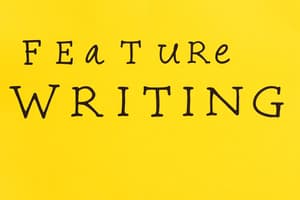Podcast
Questions and Answers
Which of the following best describes the primary goal of a profile feature article?
Which of the following best describes the primary goal of a profile feature article?
- To entertain and inform the reader, going beyond publicly available information, to reveal deeper insights into the subject's feelings, attitudes, habits, and mannerisms. (correct)
- To present only flattering information about the subject, avoiding controversy.
- To provide a chronological list of accomplishments of the subject.
- To promote the subject and their latest projects or achievements.
What is the significance of the "nut graph" in a profile feature article?
What is the significance of the "nut graph" in a profile feature article?
- It acts as a hook, showing the reader what the story is about and why this entity matters at the present time. (correct)
- It lists the sources the author used during their research.
- It is a brief summary of the subject's biographical information.
- It provides a detailed financial analysis of the subject's income.
In crafting a Q&A article, why is it crucial to avoid closed-ended questions?
In crafting a Q&A article, why is it crucial to avoid closed-ended questions?
- Closed-ended questions are difficult to transcribe accurately.
- Closed-ended questions require extensive follow-up questions.
- Closed-ended questions make the interviewer seem unprepared.
- Closed-ended questions limit the subject's response, potentially hindering the depth and quality of the article. (correct)
What is a key characteristic of a round-up feature article?
What is a key characteristic of a round-up feature article?
What is a critical element that differentiates a 'how-to' article from a 'round-up' article?
What is a critical element that differentiates a 'how-to' article from a 'round-up' article?
What is a key requirement for a personal experience article to be considered publishable?
What is a key requirement for a personal experience article to be considered publishable?
What is the hallmark of a 'true-life drama' feature story?
What is the hallmark of a 'true-life drama' feature story?
Why is it important to pitch seasonal stories well in advance of the actual season or event?
Why is it important to pitch seasonal stories well in advance of the actual season or event?
What distinguishes a successful travel feature article from a personal travel essay?
What distinguishes a successful travel feature article from a personal travel essay?
Why are evergreen stories valuable for freelance writers?
Why are evergreen stories valuable for freelance writers?
Which of the following elements is NOT a typical component of a profile's framework?
Which of the following elements is NOT a typical component of a profile's framework?
Why is immersive reporting important when writing a profile?
Why is immersive reporting important when writing a profile?
In a Q&A article, what is the primary responsibility of the interviewer during the editing process?
In a Q&A article, what is the primary responsibility of the interviewer during the editing process?
When crafting a 'how-to' article, what should a writer consider to ensure its suitability for the target audience?
When crafting a 'how-to' article, what should a writer consider to ensure its suitability for the target audience?
In the context of feature writing, what does it mean to 'think outside the box' when covering a recurring event like horse racing?
In the context of feature writing, what does it mean to 'think outside the box' when covering a recurring event like horse racing?
What is the key to identifying a strong personal experience story?
What is the key to identifying a strong personal experience story?
What should a writer focus on when developing a seasonal story?
What should a writer focus on when developing a seasonal story?
In travel writing, what does Brian Klems mean by the need to travel 'deeply'?
In travel writing, what does Brian Klems mean by the need to travel 'deeply'?
What distinguishes an excellent travel feature?
What distinguishes an excellent travel feature?
Evergreen stories are
Evergreen stories are
Flashcards
Profile Article
Profile Article
Mini-biography on a single entity (person, place, event, thing) revolving around a nut graph that includes something newsworthy happening now.
Profiles aim to:
Profiles aim to:
Goal is to reveal feelings, expose attitudes, capture habits/mannerisms, and entertain/inform.
Anecdotal Lede (Profile)
Anecdotal Lede (Profile)
Use an engaging, revealing little story to lure the reader into the article.
Nut Graph/Theme (Profile)
Nut Graph/Theme (Profile)
Signup and view all the flashcards
Scene 1 (Profile)
Scene 1 (Profile)
Signup and view all the flashcards
Chronology (Profile)
Chronology (Profile)
Signup and view all the flashcards
Where Are We Now? (Profile)
Where Are We Now? (Profile)
Signup and view all the flashcards
What Lies Ahead? (Profile)
What Lies Ahead? (Profile)
Signup and view all the flashcards
Closing Quote (Profile)
Closing Quote (Profile)
Signup and view all the flashcards
Q&A Article
Q&A Article
Signup and view all the flashcards
Round-Up Article
Round-Up Article
Signup and view all the flashcards
How-To Article
How-To Article
Signup and view all the flashcards
Personal Experience Article
Personal Experience Article
Signup and view all the flashcards
True-Life Drama Article
True-Life Drama Article
Signup and view all the flashcards
Seasonal Article
Seasonal Article
Signup and view all the flashcards
Travel Article
Travel Article
Signup and view all the flashcards
Essay or Opinion Article
Essay or Opinion Article
Signup and view all the flashcards
Historical Article
Historical Article
Signup and view all the flashcards
Trend Story Article
Trend Story Article
Signup and view all the flashcards
Evergreen Article
Evergreen Article
Signup and view all the flashcards
Study Notes
- Feature articles come in various forms like profiles and how-tos.
- Editors are more likely to consider pitches tailored to a specific format or angle.
Profiles
- A profile is a short biography focused on a person, place, event, or thing.
- Profiles should be centered on a newsworthy event occurring.
- A profile's hook explains why a subject is being highlighted at a particular time.
- Effective profiles delve into a subject's personality and recount struggles and aspirations.
- Profiles should present a complete picture, including flaws, and aim to delve into feelings, attitudes, habits, and mannerisms.
- Profiles should be both entertaining and informative.
- Immersive reporting reveals anecdotes about a subject’s interests, career, education, and family.
- Documenting habits, mannerisms, vocal tones, dress, interactions, and word choice helps readers better understand the subject.
- Interviewing skills are critical to encourage subjects to share personal details.
- The goal is to create a conversational environment, encouraging subjects to reveal their true selves, memories, opinions, feelings, and reflections.
- Interviewing multiple people provides diverse perspectives and valuable background information.
- Observing a subject in various settings provides a comprehensive understanding of them.
- Insufficient sources and limited time with a subject can lead to an incomplete profile.
Profile Framework:
- Start with an engaging anecdotal lead.
- Include a nut graph that conveys the story's essence and its current relevance.
- Show the subject in action using dialogue and descriptions.
- Chronologically recap past activities with relevant facts, quotes, and anecdotes, tying into the theme.
- Describe the subject's current activities in relation to the theme.
- Outline their future plans, dreams, goals, and potential obstacles.
- End with a closing quote that leaves the reader with a sense of resolution.
Q&A
- Easily written and read, Q&As are versatile across many topics.
- Interviewers need to ask high-quality questions that inspire thought and detailed answers.
- Q&As begin with an engaging introduction before transitioning into an interview format: interviewer, interviewee, and reader.
- A Q&A needs to feel conversational.
- The order of questions and the quality of answers are crucial.
- Editing a Q&A transcript can take longer than the interview itself.
- Eliminate redundancies and verbal fillers like "like" or "you know".
- Sentences can be edited out by using ellipses (...).
- Grammatical errors should be corrected or clarified with the subject.
Round-Up
- Feature round-ups compile suggestions from different sources around a central idea.
- Round-ups are similar to list blog posts.
- Each suggestion is typically numbered.
- Round-ups begin with an anecdote that introduces the theme.
- The body consists of sections, each presenting a suggestion with sources, facts, anecdotes, and quotes.
- The order of suggestions is interchangeable.
- Sources should have expertise, not just opinions.
How-To
- How-to articles teach readers how to do something through step-by-step directions, supplies, and suggestions.
- Unlike round-ups, how-to articles should be sequential and end with a successful outcome.
- Topics should be novel or offer a new approach to something familiar.
- Instructions should avoid being too simple or too complex.
- Definitions and anecdotes can illustrate potential successes and failures.
Personal Experience
- Personal experience articles share original, instructive moments.
- Readers should be able to relate, learn, benefit, avoid, or cope with a challenge from the experience.
- The author's experience is the story, not just an introduction as in a first-person lead.
- These articles require the author to share the good, the bad, and the uncomfortable.
- The experience should be complete before pitching.
- An author needs to have gained perspective on the issue to report it objectively.
- The experience should be attainable or achievable for readers.
The Art of Covering Horse Racing
- Thinking outside the box leads to unique stories.
- Focus on different aspects related to an event, like the owners instead of the trainer.
- Highlighting a unique aspect, like a horse's breeding style, that has not yet been told provides value to a reader.
True-Life Drama
- True-life dramas recount almost unbelievable but real events driven by compelling characters.
- They often start as news stories before evolving into in-depth features.
- Penetrating interviews are key to uncovering the "real story".
Seasonal
- Seasonal stories need a fresh angle each year and are planned in advance.
- Themes should be interwoven with a timely observance.
- Consider how a single event can be spun for different audiences.
- Pitches should be submitted well in advance, often six months to a year before the event.
Travel
- Travel pieces need original and unique angles.
- Focus on specific aspects such as budget or a unique perspective.
- The piece has to show the editor and the reader why there is a unique perspective and angle on a traveling experience.
- Travel writing includes how to travel, when to travel, and advice on traveling.
- Targeting a specific group of travelers increases the chances of a unique idea.
- Developing expertise in a subject or area can help separate a writer.
- Build up expertise in one subject or area.
- Be a curious and perceptive traveler, always looking for potential stories.
Other Types Include:
- Essay or Opinion: First-person pieces on timely subjects.
- Historical Article: Focus on a historical aspect with a current connection.
- Trend Story: Captures the current pulse of a population.
- Evergreen: Timeless stories that can be pitched anytime.
Studying That Suits You
Use AI to generate personalized quizzes and flashcards to suit your learning preferences.



